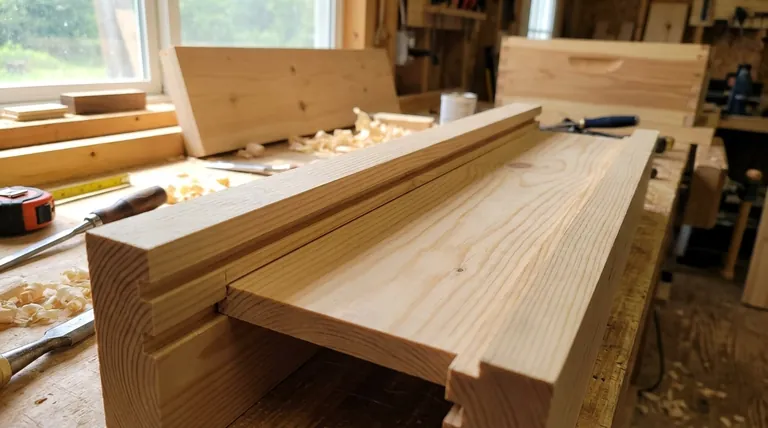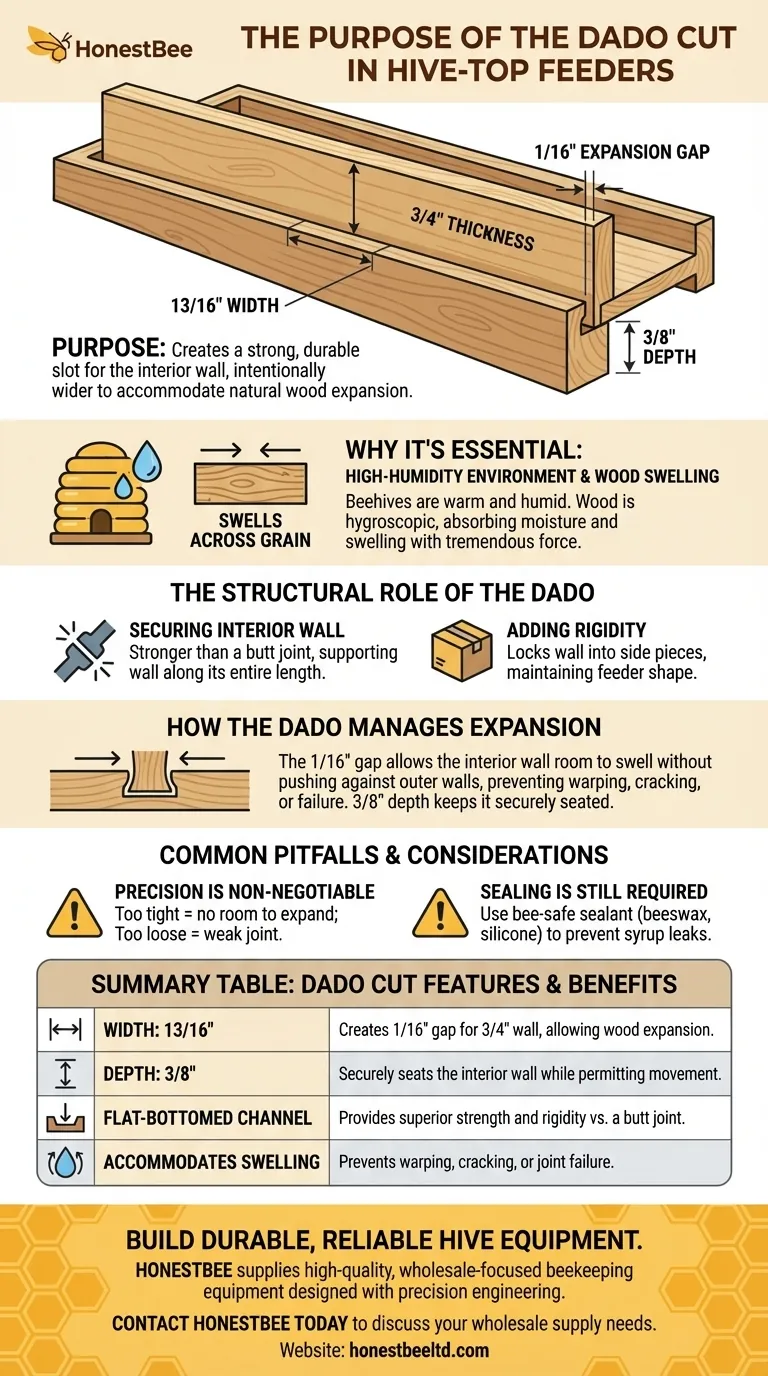The purpose of the dado cut in a hive-top feeder is to create a strong, durable slot that holds the interior wall. Crucially, this cut is intentionally made slightly wider than the wall itself to accommodate the natural expansion of the wood caused by the high humidity inside a beehive.
This specific joint is not just for assembly; it is a critical design choice engineered to prevent the feeder from warping, cracking, or breaking apart as the wood swells and shrinks with changing moisture levels.

The Structural Role of the Dado
A dado is a flat-bottomed channel cut across the grain of a piece of wood. In this feeder design, it serves two primary mechanical purposes.
Securing the Interior Wall
The dado provides a channel for the interior pine wall to sit in. This creates a much stronger connection than a simple butt joint, supporting the wall along its entire length.
Adding Rigidity to the Feeder
By locking the interior wall into the long side pieces, the dado joint adds significant structural rigidity to the entire feeder box, helping it maintain its shape.
Why This Joint is Essential for a Beehive
A simple glued joint would fail in this application. The key is understanding the environment inside a beehive and the properties of wood.
The High-Humidity Environment
A beehive is a warm and exceptionally humid place. Wood, particularly pine, is hygroscopic, meaning it naturally absorbs moisture from the air.
The Physics of Wood Expansion
When wood absorbs moisture, it swells, primarily across the width of the grain. This expansion exerts a tremendous amount of force.
How the Dado Manages Expansion
The dado is intentionally cut to a width of 13/16" to house a standard 3/4" (or 12/16") thick pine board. That extra 1/16" of space is the critical feature.
This small gap gives the interior wall room to swell from humidity without pushing against the outer walls of the feeder. A depth of 3/8" ensures the wall remains securely seated in the channel even as it moves.
Common Pitfalls and Considerations
While effective, this design requires proper execution to function correctly and prevent other issues.
Precision is Non-Negotiable
The dimensions of the dado are vital. If it is too tight, the wood will have no room to expand, defeating the purpose. If it is too loose, the joint will be weak and difficult to seal.
Sealing the Joint is Still Required
The dado manages wood movement, but it does not make the joint waterproof on its own. The interior corners and joints of the feeder must be sealed with a bee-safe material, such as beeswax or food-grade silicone, to prevent syrup from leaking.
Making the Right Choice for Your Goal
Based on this principle, here is how to approach your project.
- If your primary focus is building a new feeder: Cut your dado slightly wider than the measured thickness of your interior wall to create the necessary expansion gap.
- If your primary focus is troubleshooting a failing feeder: Examine the joints for cracks or bowing, which could indicate that the original dado was too tight and the wood expansion has damaged the structure.
Properly engineering for wood movement is the key to building equipment that will last for many seasons in the demanding beehive environment.
Summary Table:
| Dado Cut Feature | Purpose & Benefit |
|---|---|
| Width: 13/16" | Creates a 1/16" gap for a 3/4" wall, allowing for wood expansion. |
| Depth: 3/8" | Securely seats the interior wall while permitting movement. |
| Flat-bottomed channel | Provides superior strength and rigidity vs. a butt joint. |
| Accommodates swelling | Prevents warping, cracking, or joint failure in high-humidity hives. |
Build durable, reliable hive equipment that withstands the test of time. For commercial apiaries and distributors, precision-engineered beekeeping supplies are non-negotiable. HONESTBEE supplies high-quality, wholesale-focused beekeeping equipment designed with these critical engineering principles in mind. Ensure your operations run smoothly with feeders and hive components built to last. Contact HONESTBEE today to discuss your wholesale supply needs.
Visual Guide

Related Products
- Long Langstroth Style Horizontal Top Bar Hive for Wholesale
- Economy Small Scale Honey Dryer Dehumidifier Thickening Machine
- Professional Wide Blade Honey Scraper for Beekeeping and Honey Processing
- Automatic Pneumatic Bee Frame Machine for Eyelet Insertion
- HONESTBEE Bee Frame Side Bar Forming Machine Precision Engineered for High-Volume Production Bee Frame Machine
People Also Ask
- What are the box management requirements for a top bar hive vs. Langstroth? Choose Your Hive Strategy
- How does the top bar hive help control varroa mites? A Natural Approach to Mite Management
- How does the design of a top bar hive benefit beekeepers? Ergonomic & Natural Beekeeping for Hobbyists
- What are the main differences between Langstroth hives and top bar hives? Choose the Right Hive for Your Beekeeping Goals
- How are entrances designed in top bar hives? Master Beehive Layout for Maximum Honey



















